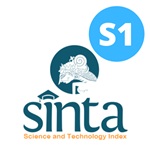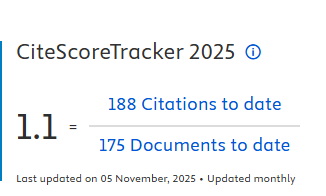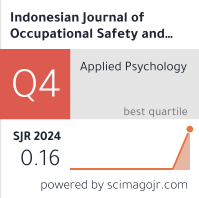The Risk Assessment of Clinical Pathology Laboratory in Universitas Airlangga Hospital Surabaya
Downloads
Introduction: Laboratory is a place for the analysis of a material that aims for research, education, quality testing and diagnose diseases. Working in the laboratory will always be faced with a variety of risk and sources of danger that can cause workplace accidents. The purpose of this study was to determine the hazards, hazard identification, risk identification, risk assessments, risk control, and residual risk in working at the clinical pathology laboratory. Method: Data collection method used was observational and descriptive research. When viewed from the time of the study, this study was cross sectional. The data used were primary and secondary data, in which the primary data were obtained by direct observation on site, while secondary data were obtained from SOPs available in the laboratory. Results: The results of the study can identify as many as 9 hazards. In the assessment of risk, it obtained the highest level of danger which was high risk. The level of risk was as high as 3 hazards including needling, splattered patient samples, and reagents or hazardous substances. Conclusion: The conclusion from the study is that this laboratory is classified as dangerous because it finds some of the highest risk levels, which is high risk. The existing risk control in this laboratory is quite complete and good, but it needs to be an improvement in terms of compliance in wearing Personal Protective Equipment (PPE) to minimize the risk.
Keywords: clinical pathology laboratory, hazard identification, risk assessment
Apladika, A., Denny, H. M. and Wahyuni, I. (2016) ‘Hubungan Paparan Kebisingan Terhadap Stres Kerja Pada Porter Ground Handling Di Kokapura Ahmad Yani Semarang', Jurnal Kesehatan Masyarakat Universitas Diponegoro, 4(4), pp. 630–635.
Bakhtiar, D. S. and Sulaksmono, M. (2013) ‘Risk Assessment Pada Pekerjaan Welding Confined Space Di Bagian Ship Building Pt Dok Dan Perkapalan Surabaya', The Indonesian Journal of Occupational Safety and Health, 2(1), pp. 52–60.
Cross, J. et al. (2004) OHS Risk Management Handbook, Hb 205:2004. Sydney: Standards Australia International Ltd.
Hakim, A. R. (2017) ‘Implementasi Manajemen Risiko Sistem Kesehatan, Keselamatan Kerja dan Lingkungan (K3L) pada Pembangunan Flyover Pegangsaan 2 Kelapa Gading Jakarta Utara', Media Komunikasi Teknik Sipil, 23(2), p. 113.
Harrianto, R. (2008) Buku Ajar Kesehatan Kerja. Jakarta: E.C.G.
Husni, L. (2003) Hukum Ketenagakerjaan Indonesia. Jakarta: PT. Raja Grafindo Persada.
Kartikasari, D., Nurjazuli and Mursid, R. (2016) ‘Analisis Risiko Kesehatan Pajanan Benzene pada Pekerja di Bagian Laboratorium Industri Pengelolaan Minyak Bumi', Jurnal Kesehatan Masyarakat, 4(4), pp. 892–899.
Kementerian Kesehatan Republik Indonesia (2009) Profil Kesehatan Indonesia Tahun 2009, Kementrian Kesehatan Republik Indonesia. Jakarta.
Kurniawati, E., Sugiono and Yuniarti, R. (2014) ‘Analisis Potensi Kecelakaan kerja pada Departemen Produksi Springbed dengan Metode Hazard Identification and Risk Assessment (HIRA) (Studi Kasus : PT . Malindo Intitama Raya , Malang , Jawa Timur)', Jurnal Rekayasa dan Manajemen Industri, 2(1), pp. 11–23.
Kusumadewi, S. (2017) Berbagai Reaksi Alergi Terhadap Dental Material di Kedokteran Gigi. Undergraduate Thesis. Denpasar: Faculty of Medicine. Universitas Udayana.
Marbun, R. J., Puspitasari, N. B. and Budiawan, W. (2015) ‘Identifikasi dan Analisis Risiko Keselamatan dan Kesehatan Kerja pada Area Produksi PT. Pelita Cengkareng Paper', Industrial Engineering Online Journal, 4(4).
Martalina, S., Yetti, H. and Lestari, Y. (2018) ‘Identifikasi Bahaya dan Risiko Keselamatan Kerja Pada Saat Overhaul di Area Kiln PT. X tahun 2017', Jurnal Kesehatan Andalas, 7(1), p. 14.
Minister of Manpower (1970) Nomor 1 Tahun 1970 Tentang Keselamatan Kerja. Jakarta: Minister of Manpower.
Minister of Manpower (2003) No 13 Tahun 2003 tentang Ketenagakerjaan. Jakarta: Minister of Manpower.
Minister of Manpower (2012) Nomor 50 Tahun 2012 Tentang Penerapan Sistem Manajemen Keselamatan dan Kesehatan Kerja. Jakarta: Minister of Manpower.
Muhani, N., Nuryani, D. D. and Indriyani, E. (2018) ‘Analisis Risiko Keselamatan dan Kesehatan Kerja di Laboratorium RSUD Dr. H. Abdul Moeloek Provinsi Lampung', Jurnal Dunia Kesmas, 7(4), pp. 178–185.
Mukhlish, W. I. N., Sudarmanto, Y. and Hasan, M. (2018) ‘Pengaruh Kebisingan Terhadap Tekanan Darah dan Nadi pada Pekerja Pabrik Kayu PT. Muroco Jember', Jurnal Kesehatan Lingkungan Indonesia, 17(2), p. 112.
Ngatijo et al. (2016) ‘Penilaian Resiko K3 Pada Pengujian Kandungan Uranium Menggunakan Alat Titroprosesor', Pengelolaan Instalasi Nuklir, 9(16), pp. 44–57.
Permana, A. A., Nugraha, W. D. and Hadiwidodo, M. (2013) ‘Analisis Manajemen Risiko Studi Kasus: Unit Pelaksana Teknis Balai Pengujian dan Laboratorium Lingkungan Hidup Badan Lingkungan Hidup Provinsi Jawa Tengah', Journal of Chemical Information and Modeling, 53(9), pp. 1689–1699.
Phuspa, S. M. (2017) ‘Hubungan Resiko Ergonomi dengan Kejadian Musculosceletal Disorder pada Pengguna Laboratorium Teknologi Pertanian Universitas X', Indonesian Journal for Health Sciences, 1(1), pp. 30–36.
Prasetyo, E. H., Suroto and Kurniawan, B. (2018) ‘Analisis Hira (Hazard Identification and Risk Assessment) Pada Instansi X Di Semarang', Jurnal Kesehatan Masyarakat (e-Journal), 6(5), pp. 519–528.
Putra, I. O. (2018) ‘Manajemen Risiko pada Laboratorium Biofarmasetika dan Analisis Farmasi Fakultas Farmasi Universitas Airlangga', The Indonesian Journal of Occupational Safety and Health, 7(1), pp. 81–90.
Sarastuti, D. (2016) Analisis Kecelakaan Kerja di Rumah Sakit Universitas Gadjah Mada Yogyakarta. Undergraduate Thesis. Surakarta: Faculty of Health Science. Universitas Muhammadiyah Surakarta.
Sokhibi, A. and Primadasa, R. (2018) ‘Analisis Resiko Musculosceletal Disorder pada Pengguna Laboratorium Ergonomi dan Perancangan Sistem Kerja Teknik Industri Universitas Muria Kudur', Jurnal Rekayasa Sistem Industri, 3(2).
Subamia, I. D. P., Sriwahyuni, I. G. A. N. and Widiasih, N. N. (2019) ‘Analisis Resiko Bahan Kimia Berbahaya di Laboratorium Kimia Organik', Wahana Matematika dan Sains : Jurnal Matematika , Sains , dan Pembelajarannya, 13(1), pp. 49–70.
Winarno, H., Suryoputro, A. and Shaluhiyah, Z. (2008) ‘Faktor-Faktor Yang Berhubungan Dengan Penggunaan Jarum Suntik Bergantian Diantara Pengguna Napza Suntik Di Kota Semarang', The Indonesian Journal of Health Promotion, 3(2), pp. 74–85.
Wulandari, D. and Widajati, N. (2017) ‘Risk Assessment Pada Pekerja Pengelasan Perkapalan Dengan Pendekatan Job Safety Analysis', The Indonesian Journal of Occupational Safety and Health, 6(1), pp. 1–15.

In order to be accepted and published by The Indonesian Journal of Occupational Safety and Health, Author(s) who submit an article should complete all the review process. The copyright of received articles assigned to the The Indonesian Journal of Occupational Safety and Health and Department of Safety and Health, Universitas Airlangga as publishers of the journal. The intended copyright includes the rights to publish articles in various forms (including reprints).
The Editorial Team of The Indonesian Journal Of Occupational Safety and Health and Department of Safety and Health strive to ensure that no errors occur in the articles that have been published, both data errors and statements in the article.
Users of this website will be licensed to use materials from this website following the Creative Commons Attribution-NonCommercial-ShareAlike 4.0 International License. No fees charged. Please use the materials accordingly.
------------------------------------------------------------------------------------------------------------------------------------------------------------------------------------------
Attribution ” You must give appropriate credit, provide a link to the license, and indicate if changes were made. You may do so in any reasonable manner, but not in any way that suggests the licensor endorses you or your use.
NonCommercial ” You may not use the material for commercial purposes.
ShareAlike ” If you remix, transform, or build upon the material, you must distribute your contributions under the same license as the original.







 How to Submit Articles in OJS
How to Submit Articles in OJS

























